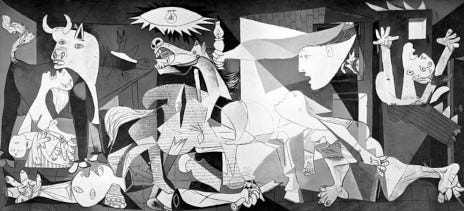Dear friends,
Many years ago - right around this season - I first viewed Pablo Picasso’s seminal opus, Guernica, at the Museo Reina Sofía in Madrid.
It is arguably the greatest anti-war painting of all time, a massive work over 3 meters tall (11+ feet) and 7 meters wide (25+ ft), created in response to Nazi Germany’s 1937 bombing of the town, Guernica, in Spain’s northern Basque Country.
Describing the full impact the painting had on me would be impossible. The sheer violence and anguish ripping across the canvas possessed a diabolical energy, a depiction of suffering that carved itself into my very being.
I stood there, transfixed, tears streaming down my face, for nearly an hour, my eyes going over the canvas again and again, attempting to sear every detail, every line, every shape into memory.
After viewing the work, I spent the following two days ensconced in a concert hall for a series of grueling recording sessions.
Part of that recording included two of my favorite works by Franz Liszt: Sonetto 104 del Petrarca and Apres Une Lecture Du Dante.
Both pieces are from Liszt’s larger suite for solo piano, Années de Pèlerinage: Italie (1838-1849), which was composed during his years in Italy.
Sonetto 104 is based on and inspired by the following sonnet by Petrarch:
Warfare I cannot wage, yet know not peace;
I fear, I hope, I burn, I freeze again;
Mount to the skies, then bow to earth my face;
Grasp the whole world, yet nothing can obtain.
Pris'ner of one who deigns not to detain,
I am not made his own, nor giv'n release.
Love slays me not, nor yet will he unchain;
Nor life allot, nor stop my harm's increase.
Sightless I see my fair; though mute, I mourn;
I scorn existence, yet I court its stay;
Detest myself, and for another burn;
By grief I'm nurtured; and, though tearful, gay;
Death I despise, and life alike I hate:
Such, lady, do you make my wretched state!
As the name suggests, the second piece - Apres Une Lecture Du Dante (commonly called the “Dante Sonata” in English) - was inspired by The Divine Comedy, a work of literature that had a massive impact on me during my formative years.
Like Guernica, dark turmoil, unsettling tension, and an agitated, violent passion imbue Liszt’s language, a desperation arising from the inherent dissonance between what we desire and what limits us.
Picasso portrayed human nature’s external conflict; Liszt examined the internal.
I first studied and performed these Liszt pieces during my teen years. My initial artistic interpretation rested upon the literary works they were based on and the romantic nature of their style.
It made sense to me that the end of the Dante Sonata would exude such brilliant, heroic triumph…the arrival of Paradiso after the horrors and tribulations of Inferno and Purgatorio.
I also believed the ending of Sonetto 104 reflected a journey of overcoming - a resigned acceptance of the maddening contradictions of love and the human desire to spiritually transcend it.
My original youthful interpretation essentially hinged on a common cultural idea, the apotheosis of a narrative expounded by Western Christianity: that attainment of peace and joy is only deserved - and can only be reached - after great struggle and anguish.
It was a binary mode of interpretation, a linear understanding trapped in the land of either / or.
However, when I recorded both works after experiencing Picasso’s Guernica, I felt and approached them differently.
Because the tears I’d shed while viewing the painting were not from sorrow; they came from being so deeply moved by the work’s humanity.
They were tears of joy.
Yes, we are capable of inflicting terrible pain on ourselves, on others, on our planet, and on other living beings.
But we are also capable of acknowledging and recognizing those horrors…of grasping and confronting the full complexities of what it means to be human.
A fellow human being who loved, doubted, laughed, grieved, and despaired - a person as flawed and imperfect as every single one of us - gave birth to these creations out of nothing.
When no sound or melody or harmonic progression existed, Liszt articulated our universal existential challenges at the piano.
When nothing existed but a blank canvas, Picasso vividly brought the pain of our world to life through the strokes of his hand.
And despite the conflicts - internal and external - from which they were born, these artistic expressions are not a glorification or romanticization of suffering.
They are a loud rejection of it, a defiant declaration carving out space for the entirety of who we are.
How remarkable is the power of human expression.
It is through the very nature of that expression that we question.
We connect. We consider. We grow.
We change.
In seasons of despair, we do not find joy.
We create it.
We nurture it with our hands and touch, with the art born of our lived experiences and individual truths.
We breathe it with each step, gesture, and movement.
We embrace it by inviting others to entwine their journeys with ours.
We vocalize it through song, story, conversation, and laughter.
We embody it through kindness and care.
To live is a profound expression of hope, a claiming of not just the darkest parts of us…but also the most extraordinary.
Happy Holidays, everyone.
Wherever you are, I wish you a beautiful season of love and peace, a time of both reflection and aspiration.
May you celebrate the exquisite, priceless beauty of humanity, both yours and of others.
May you actualize the joy that is your inherent right and in doing so, assert a power and freedom that has always belonged to you.
All my love,
G





